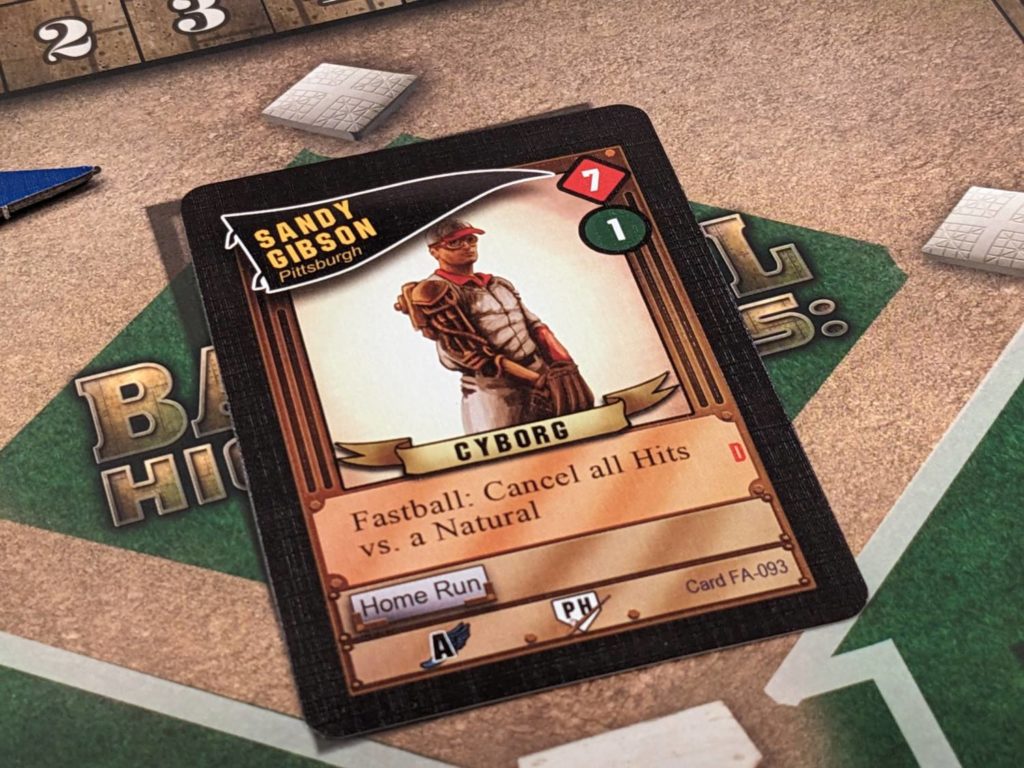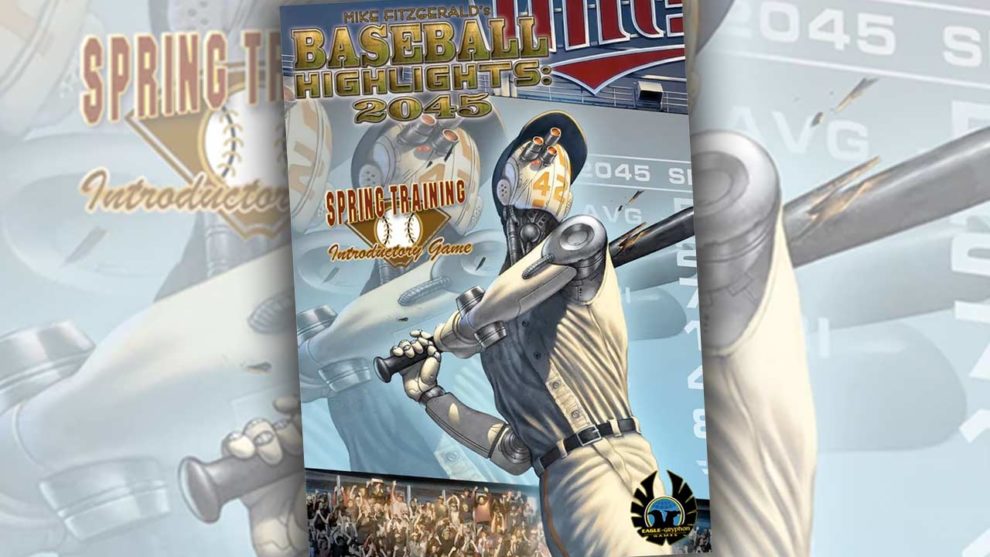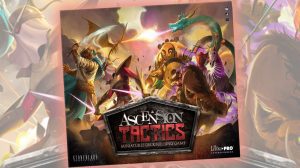Disclosure: Meeple Mountain received a free copy of this product in exchange for an honest, unbiased review. This review is not intended to be an endorsement.
Although the NBA is my main port of call when it comes to sports passion, I used to be a bigger fan of baseball.
I grew up in Rochester, New York, watching the Rochester Red Wings (a AAA affiliate that fed the Baltimore Orioles at the time) at a podunk field a half-hour from my house. It was great. Cheap tickets and cheaper food, with every seat in the house providing a fantastic view of the field. The best thing about the Red Wings? They played against all of the other teams that were the final farm system stop for the teams I really cared about, like the New York Yankees and the Boston Red Sox. It was cool to get a preview of the players who would eventually end up on the biggest stage.
I played baseball from T-ball leagues all the way through high school. Like most prospects, my dreams were make-or-break based on the breaking ball. I was a home run-hitting outfielder and first baseman, and I had the chance to start on my high school team through sophomore year.
Then, during my junior year, it seemed like everyone was throwing curveballs. And, so began the end of those aforementioned dreams. (I’ll always have softball, though. Even though it feels too easy, I love hitting home runs in softball too. And, no curveballs!)
So between playing baseball and watching baseball, I’ll always have a spot in my heart for songs like “Take Me Out to the Ballgame.” And I’ll always try a baseball-themed tabletop experience and it was a delight to be given the chance to review Baseball Highlights: 2045—Spring Training (2017, Eagle-Gryphon Games).
Spring Training is the introductory module for Baseball Highlights: 2045. Here’s how well the series has fared since being introduced in 2015: BGG lists more than THIRTY expansions for the game, from promo packs to extra starting teams, individual players and different ballparks to play in.
For this review, I stuck to solo play; the game plays either solo or head-to-head with only two players. Since my wife had no interest in this one and I had trouble convincing other gamers in my network to drop by for a series of baseball mini-games, I blazed my own trail.
Baseball Highlights: 2045—Spring Training is a fun puzzle that makes sense and pays tribute to many of my childhood baseball heroes. The main key here for solo play? You’re going to really need to level the playing field before taking on the game’s AI program.

Wait…A Cyborg?
In the imagined future of the year 2032, baseball was on its last legs. (Which is funny, because in real life 2021, baseball really was on its last legs as a spectator sport before the rules committee for Major League Baseball decided it was time to speed everything up. Hello, pitch timers!) So in this imagined future, human pitchers were allowed to play with bionic arm implants and soon came to dominate the league from a pitching perspective.
In 2041, the league decided to level things off by creating robotic hitters that could keep up with bionic-armed pitching staffs. Now, it’s 2045, and “naturals” (100% human players) are trying to compete alongside both cyborgs and robots, creating a league unlike anything in history.
Up to two players step into the shoes as combination manager/GMs, leading a team of 15 players onto the field of play against each other for a chance to win a series of games. You could play just a few games or something as grand as a World Series if that’s what you are into.
Each player has a deck of 15 starter players, many of whom are terrible. Baseball games of the future are only six innings long, so in any given inning, players will draw a hand of six cards from their Lineup (deck) and choose which player card to use in each inning. Just like baseball IRL, the visiting team gets to go first, and the home team will go second in each inning.
Rounds consist of opponents playing all of their six cards. Each card is broken down into an instant action area, which sometimes has effects that cancel the hits of the opponent or provide a chance to steal bases to advance runners on the basepath. A player plays a card and resolves any instant effects, then looks at the hits listed on the opposing player’s card.

If nothing funny happens, then the opposing player’s card hits happen in the order they are listed. That might mean that a single is hit, then a home run. Any hits advance runners already on the base path of that player’s board. Then, hitters listed on the active player’s card are placed on home plate, awaiting their chance to run and score based on what the other player lays down next.
This goes on until all 12 cards are played. Because the visiting team played a card before the home team had played any cards, the home team gets one final chance to resolve the hits on their card before the game ends. The team with the highest run total wins that mini-game.
After each mini-game, players can use the total revenue generated on the cards played (similar to generating coins or buy actions in other deckbuilders like Clank! and GI JOE Deckbuilding Game) to buy Free Agents from a pool of six available cards. This is the way to get those stinkers out of your deck for future mini-games. Usually each human player can buy just one Free Agent from the market, maybe two; these new cards get added to the top of the Lineup deck so that they can be used in the next mini-game.
The first team to win four out of seven mini-games is the winner of the overall series and the game.
This back-and-forth may sound a little wonky on paper, and it was wonky when I first walked through a game of Baseball Highlights: 2045—Spring Training. But after maybe two innings of play, I had it down pat. The system here is really intuitive, and it becomes a little addictive to run through a game in solo play.
I knocked out three straight complete games in about 80 minutes. Solo play flies by, because the solo AI is so easy to run. The AI, which always plays as the home team, gets a deck of 15 Free Agents and just deals itself the top card to play on its turn. (The human opponent always has the choice of any remaining cards in hand.)
That also means the starting AI deck is way, way better than your deck; all Free Agents are better than the starting deck players. That’s the only problem you have to work around in determining ways to kick off a game of Spring Training.

Mission: Impossible
Before I read the fine print, I was playing against the AI (a full deck of 15 ringers) with the Los Angeles starting deck. I lost my first two series 4-0 and only one of those eight games was close; in one of those games, the AI won 10-1.
On my third try at a series win, I lost 4-1, with my only win coming on a three-run homer in extra innings.
Then I did read the fine print: designer Mike Fitzgerald suggests doing at least two market buy rounds before playing against the AI in a seven-game series. I went farther, and did four market rounds before taking on the AI. Even then, the AI kept winning, but games were significantly more interesting because they were actually competitive.
Even though solo play is enjoyable, particularly as a video game fan who enjoys getting punched in the face with really challenging games like Dark Souls and Bloodborne, it is clear that Baseball Highlights: 2045—Spring Training is a game best played with two humans facing off with relatively equal teams. That’s because the mind games would be a trip when figuring out which card to play, and when.
That’s also where Pinch Hitting comes into play. Each player can start a mini-game by placing one of their six cards in the On Deck circle of their player board. This card may or may not come into play, but gives each player an option to pivot based on what the other player does throughout the round.
I love Pinch Hitting, even against the AI. Keeping a player with the “Glove” power (cancels one opposing base hit) nearby is crucial…but maybe it is even MORE crucial to keep a home run hitting in the On Deck circle in case you need a big hit to end play.
Tense cardplay with easy-to-teach rules? If I had a steady deck-building fan as a neighbor, I would be playing Baseball Highlights: 2045 all the time. And if you are looking for more ways to spice up the base game, Fitzgerald and the folks at EGG have got you covered with more card expansions than you can shake a stick at.
Baseball fans, rejoice. Baseball Highlights: 2045—Spring Training does right by all of us who grew up loving the game. I’m surprised I never had the chance to play this before now, but I’m certainly glad I got there!












Add Comment